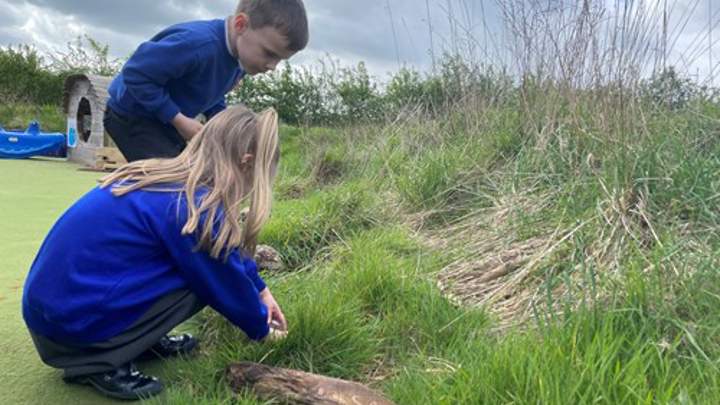
Wildflower meadow at Ashperton Primary Academy
In June 2023, Herefordshire Council’s Greener Footprints initiative ran a poster competition for primary schools across the county, inviting their students to create posters that celebrated the natural environment, under the theme ‘Our Herefordshire, Our Planet’.
Winning submissions from each of the three age categories were awarded with £250 toward an environmental education project at the school. Ashperton Primary Academy submitted a number of entries and bagged the top spot for the Early Years category with a gorgeous submission from Mila Williams.
With the £250 prize money the school elected to purchase a number of bug pots, magnifiers and ID sheets for British plants and invertebrates – with purchases made, and insect ID season around the corner, we made a visit to the school to learn about plans to use the equipment, and much more!

Head teacher Chris Bandfield and Deputy Head Caroline Bullock share the exciting projects and plans on the horizon for Ashperton Primary Academy.
With a winner in the Early Years category and runners up in the two other categories, what can you share about how you engaged the children and staff in the competition?
Caroline
Our curriculum is very largely led by the 17 Sustainable Development Goals, (SDG’s) – the students have a SDG assembly every other week and each week a competition is set, and this one fit in to the competition. The idea is that all of the students are involved in thinking about the SDG’s and not just the students but the parents as well.
SDG’s are sustainable development goals, set by the UN, to be achieved by 2030 in order to save our world.
We run lots of competitions internally - it might be a litter pick one week, or a poster competition, and every Easter Chris sets them a task to take home wildflower seeds to plant and invites them to take pictures of the flowers growing. Some competitions might be around climate, and others around our waterways, and others around equality of education – this one was around climate so just fitted in perfectly.
You used the £250 to buy bug pots, magnifiers and ID sheets for insects. How did you decide what to spend the money on?
Chris
We’ve been very lucky with the timing – we’ve got the long term lease of a 7 acre field through the amazing support of Ashperton Consolidated Charities, and the field just lends itself to developing a wildflower meadow. We’ve also put deer fencing up, and planted 400 trees from the Woodland Trust, and this was just a logical extension really.
We contacted Herefordshire Meadows, who were able to respond really quickly. They paid for us to harvest some green hay, about 5 acres from a local donor field. We spoke to the children all about this, and they went out and watched the process taking place. We spread the hay straight away on our field, with a view to turning it into a wildflower meadow – the meadow from where we got the green hay is really strong [with] at least 20 species of native wildflowers.
We did that last year, so it all came together in a really timely fashion, and meant that with the funding [that came from the competition], we bought bug pots, ID sheets, and magnifiers. It sort of snowballed really!
The meadow sounds like a great opportunity for learning, as well as for conservation. Have you seen much on the site as yet?
Chris
It’s just this last week that we have seen that Yellow Rattle has establish itself, which should parasitize the grass and encourage other wildflowers to grow. The site is poor, rather than rich agricultural lay, which is perfect! So fingers crossed, though
it will probably be a two year process for some of the perennial species to show.
Caroline
We are hoping we get something though, with wildflower meadow week coming up. We have made it into wildflower meadow term here, and based a lot of the curriculum around being outside, using the equipment, which will allow us to see year on year changes. We did think about doing meadow week, just a one off week that we could fill with lots of lovely ideas, but actually we want it to be sustainable, so next year we’re not re-organising just a one off week, but actually is something we do all the time as part of the curriculum.
Can you explain a little how the children are making use of the equipment?
Chris
It’s about the children being able to catch things without hurting them, about providing them with something they can pick up invertebrates with safely, magnify it and look at it. What’s brilliant is the youngest children’s ability to look at tiny things. It’s the best thing, they are so excited about it.
Caroline
And that’s what our EYFS (Early Years Foundation Stage) are doing now, they’re out, bug hunting! It’s really nice to have a set [of bug pots] that they can all go out with their own.
And with the ID cards as well, actually – the children love going out with them and using them outside, but even in the classroom they love just sitting there and reading them. Other classes have used them in computing to create branching databases, which you can use in the identification through following the track. They’ve been using them in all sorts of ways – invariably if you go in and it’s reading time, you’ll see a great big group, reading them, talking about them, calling Chris over and saying ‘Look at this one, Mr. Bandfield!’ So they’re really engaged.

Chris
We received support from Hidden Herefordshire, Tim Kay came in the Autumn last year with sweep nets and worked with the children right up from Reception. We’ve seen an unbelievable difference in the children. They now find the tiniest bugs, tiniest shield bugs, tiniest spiders, tiniest snails at playtimes and are careful with them.
What other engagement have you had with the site?
Chris
Herefordshire Meadows also donated Ox Eye Daisy seeds, which will give the children a bit of colour straight away. Often the colour comes later, with the flowering perennial species, many of which are food plants for butterflies etc.
Caroline
The children have been involved in every step – they’ve been able to watch the machinery working, we’ve had sheep so they’ve had some sheep talks and talks around the sustainability of wool…
Chris
…We’ve had to graze it - the grazing is key to the establishment of the wildflower meadow, as it takes down the competing grass. We had a brilliant presentation for the children, and a sheepdog demonstration. There was discussion around the sustainability of wool, how carbon is sequestered and about the plastic present in many clothes, which can get washed into the ocean, that sort of thing.
And then it snowballed even further because a local charity gave us some money for a wildlife camera. It was almost too successful! Instantly, each weekend it was out, we had badgers, foxes, muntjac deer, we had fallow deer, buzzards, jays.
It’s been really eye opening for us as well, because the children’s knowledge of native wildlife is quite limited – and they have been amazed to see what is sharing their school grounds.
But they’ve had brilliant footage – they’ve had deer in the snow, deer really close to the camera, it’s been incredible and they’ve had real wow moments which is what school should be about.
What else? We also been sponsored to put up two camera bird boxes, and we think one might have been successful. They’ve started building in it - blue tits, I think - but we’ll see how that goes.
What’re your hopes for the project?
Chris
I’m hoping that once teachers, staff, and parents also have access to the field, and also see the beauty, and how quickly things can turn around, I’m hoping that it will impact well-being. Just the joy of it, enjoying it, the chill time, I’m hoping the children start learning that as well. Well, I think they already are.
I’m hoping it will be just a nice place for people to be, and we’ll encourage our parents – if they park up and want to walk down there that’d be really nice. It’s just about teaching everybody, and really quickly, because our natural world is disappearing fast.
I still see opportunities here that are massive. But it’s a step at a time, but when you’ve got children living in an area like this…
Caroline
..that can’t recognise a badger..
Chris
.. it would be wrong not to do it. And they’ve loved it! They’ve absolutely loved it. And [the staff] have really enjoyed seeing the camera footage.
Caroline
All the staff have really jumped on board.
Chris
They’ve done really, really, well.
Caroline
It’s a chance to learn, alongside the children. And again, using the identification guides, allows you to learn as well.
So what’s next?
Chris
Hopefully we’ll be pressing flowers! Obviously we teach the children that you shouldn’t pick them but if they’re about to be mowed… and we’re hoping to grow some non-native flowers in our garden that the children can press. We’ve planted a non-native bed in our garden recommended for butterflies. Obviously we want the native plants but non-native plants can possibly play a part, so that’s just an interesting little side experiment.
What’s next? See how it goes… see how staff feel about it. If there’s not the will behind it then it will change but currently there is. I’m hoping that as staff become more aware and more interested, then it will gain its own momentum. Hopefully parents will become appreciative of it, and they’ll learn, alongside their children.
Caroline
What I’d really like... I tried really hard to win an outside classroom, because we take our learning outside but then you’ve got to come back inside to do the follow up. It would be really nice to have that outside learning space.
Chris
I know there are curriculum pressures, and we have been a consistently high performing school in terms of outcomes for children, and the world says we have got to be careful to maintain it, but my vision is that children and teachers out there have a really nice time.
It would be nice if other schools were interested, to come and have a look – I’d happily open it to other schools.
Next steps. I’d like a pool. A pond would be good. We’ve actually got three ponds, we’ve got great crested newts on site, but I know the kind of pond I’d design to get the dragonflies in. A long thin pond that 30 children can stand alongside and just watch. But pond liners are expensive… What else do we need… Giraffes?
Huge thanks to Chris and Caroline for sharing their time, passion and experience with us. For any schools looking to make contact or arrange a visit to Ashperton Primary Academy, please contact climate@herefordshire.gov.uk and the team will be happy to help.

